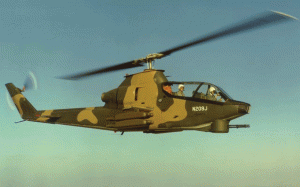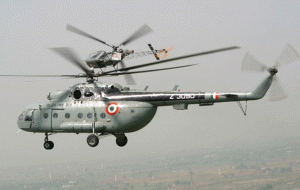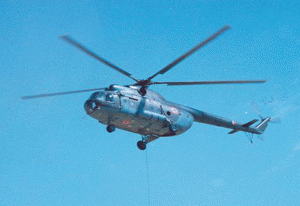The Korean War of the 1950s provided the opportunity and experience to the US military in the employment of helicopters. Old roles were refined and new ones formulated. The Bell H13 Sioux was used for medical evacuation and observation while the Sikorsky H19 was used for medical evacuation, liaison and troop transportation. General Mathew Ridgway, the UN Force Commander, asked for four transport helicopter battalions in 1951. The large-scale deployment of helicopters in Korea underscored the potential of the helicopter for assault operations in addition to medical evacuation and logistics. During the Suez Operation, when a commando assault was launched on November 06, 1956 on Port Said, the British moved 415 men and 25 tonnes of stores ashore from two British carriers in an hour and a half using 16 Whirlwind and six Sycamore helicopters, a classic illustration of the helicopter providing the field commander with the dominance of manoeuvre.
While the roles of the helicopter were being refined on the battlefield, technology continued to empower the rotary wing machine. The first turbine powered helicopter design flew in 1951 while the first such production helicopter, the French Alouette II, appeared in 1955. It is still used by the military all over the world including the Indian Armed Forces. Materials used in construction became lighter and cheaper, engine size and weight reduced and transmission design problems became less difficult to surmount. As design developed and power-to-weight ratios increased, military thinking intuitively found attractive the idea of arming the helicopters to empower the field commander with firepower in the third dimension to assist his manoeuvre. The Navy had similar thoughts too. Indeed, some military historians credit the US Navy with the first attempts to weaponise a helicopter. In an experimental flight in November 1950, 0.30 and 0.50 calibre machine guns were fitted on to jury-rigged swivel gun mounts replacing the doors on a Sikorsky HO3S-1. The recoil of the gun nearly tore off the sides of the fuselage but the ingenuity of the idea set the path for evolution of the helicopter as a combat platform. In the naval context, the helicopter was and is being used in Anti-Submarine Warfare, Anti-Surface Warfare, Over-The-Horizon targeting by ship-borne weapon systems, Airborne Early Warning, Tactical and Logistic support.
The French made extensive use of helicopters in Algeria beginning 1954, arming them with machine guns, rocket pods and air-to-ground missiles. By ceasefire in 1962, the French had over 600 helicopters operating in transportation, evacuation, recce and fire support roles in Algeria. During the late 1950s, the US Army realised the advantage of using helicopters for battlefield recce and observation over fixed wing aircraft. It issued a Light Observation Helicopter (LOH) requirement to replace Bell H13 and Hiller H23. The Hughes OH6 Cayuse Light Utility Helicopter which entered service in September 1966, went on to become “the most popular helicopter of the Vietnam War”. However, rising costs of production led to rejuvenation of the LOH competition in 1967, the end of OH6 production in 1970 and its replacement by Bell OH- 58A Kiowa.
Unlike other military platforms, the helicopter was first used on the battlefield not in offensive roles but for casualty evacuation…
The 1950s and 1960s produced several significant types of helicopters. Apart from the French Alouette II, which was the first turbine powered helicopter introduced in 1955, others that followed were the British Westland Wasp/Scout was one of the best designs produced by the British helicopter industry (1958), Kaman K600, the first US helicopter to have a twin turbo-shaft design (1958), Soviet Mi-8 (a turbine engine evolution of the Mi-41961) whose variants, especially the Mi-17 series, continue to provide excellent service even today.
The Vietnam War has a significant place in the history of military helicopters. The battlefield was ideally suited to the attributes of the helicopter and so was the war scenario. Initially, helicopters were used for combat SAR (HH43Bs operating from Thailand). Later, HH34F detachments were mounted in South Vietnam. In 1965, CH3Cs arrived in Thailand. With a range of 800 kms, these could penetrate deep into North Vietnam. The same year, the CH3C demonstrated in-flight refuelling from a Marine Corps KC135 F tanker and, by 1967, this was routine for combat SAR missions.
Vietnam brought out the need for an armed helicopter to escort other helicopters carrying troops and equipment, and to provide fire support to forces after landing in the battle zone. In 1962, the US Army’s Howze Board (an extensive study of the US Army’s aviation requirements led by Lt Gen Hamilton H Howze) concluded in its report that “Adoption of the airmobile concept is necessary and desirable. In some respects, the transition is inevitable, just as was that from animal mobility to motor.” Thus the 1st Air Cavalry Division (Airmobile) was formed. After prolonged delays and business machinations, Bell Model 209 won the contract for the Advanced Aerial Fire Support System for the Airmobile helicopters. Bell-209 first flew as the AH1 Cobra in October 1966 and its first production model rolled out in 1967. It deserves a special mention in the annals of military helicopter evolution in as much as it was termed as a “gunship” and marked that point in the history of the helicopter at which design moved away from the generalised use as an airborne platform to becoming a specialised task-oriented combat platform.
The arrival of the AH1 Cobra in Vietnam was a notable event. With the capability to carry guns, grenade launchers, rockets and missiles, it proved to be very effective in reducing the vulnerability of helicopters it was escorting during the landing phase while inducting troops into battle. Hits on helicopters dropped from 0.011 per flying hour to 0.0074 for the escorted helicopters. One of the notable successes of helicopters in Vietnam was the evacuation of 1479 personnel by nine helicopters from Saigon on April 29, 1975, during Operation Frequent Wind.
The Korean War of the 1950s provided the opportunity and experience to the US military in the employment of helicopters…
Troop and cargo transportation became an important role for helicopters. During this period there was notable development of heavy lift helicopters in the USSR. While the rest of the world was focussed on light and medium helicopters optimised for battlefield and sea-faring roles, Soviets addressed heavy lift too. The Mi-6, which first flew in 1957, could carry more than 20 tonnes of load and was the world’s largest helicopter then. In the 1960s, this type evolved into the Mi-10 which could carry 15 tonnes externally. The Sikorsky CH-54 Tarhe and the French Aerospatiale SA321 Super Frelon also flew in the 1960s but the Soviet Mi-26, which first flew in 1977, is still the world’s largest helicopter today with a payload of 20 tonnes. A mention must be made of the Soviet Mil V12 which was an unusual test vehicle with two rotors mounted side by side at the ends of a large wing; the distance from one rotor disc to the other was 220 feet, larger than the wing span of a Boeing 747. It could carry a whopping 40.205 tonnes and, although it never went into production, it still holds the world record for payload.
Post Vietnam Scenario
The Vietnam War served to instate the helicopter as an indispensable and versatile combat platform. The fulfilment of some of the innovative roles was possible as new types became available and existing types were modified for emerging demands. Even after US withdrawal from South East Asia, the Cold War sustained helicopter development. One motivation was the seemingly ever-imminent massive showdown in Central Europe, and the other, the rivalry in regional conflicts. The US experience in Vietnam led to the perceived need for considerable armament onboard helicopters; guns, cannons, rockets, air-to-surface missiles and even air-to-air missiles were added thus turning them into combat aircraft with stub wings and hard points. Vietnam served to highlight the need for increased speed, manoeuvrability, agility and survivability for helicopters and led to the development of the AH56 Cheyenne which would have been a helicopter pilot’s dream machine but for the fact that it was too expensive to mass produce, even for the US Army.







